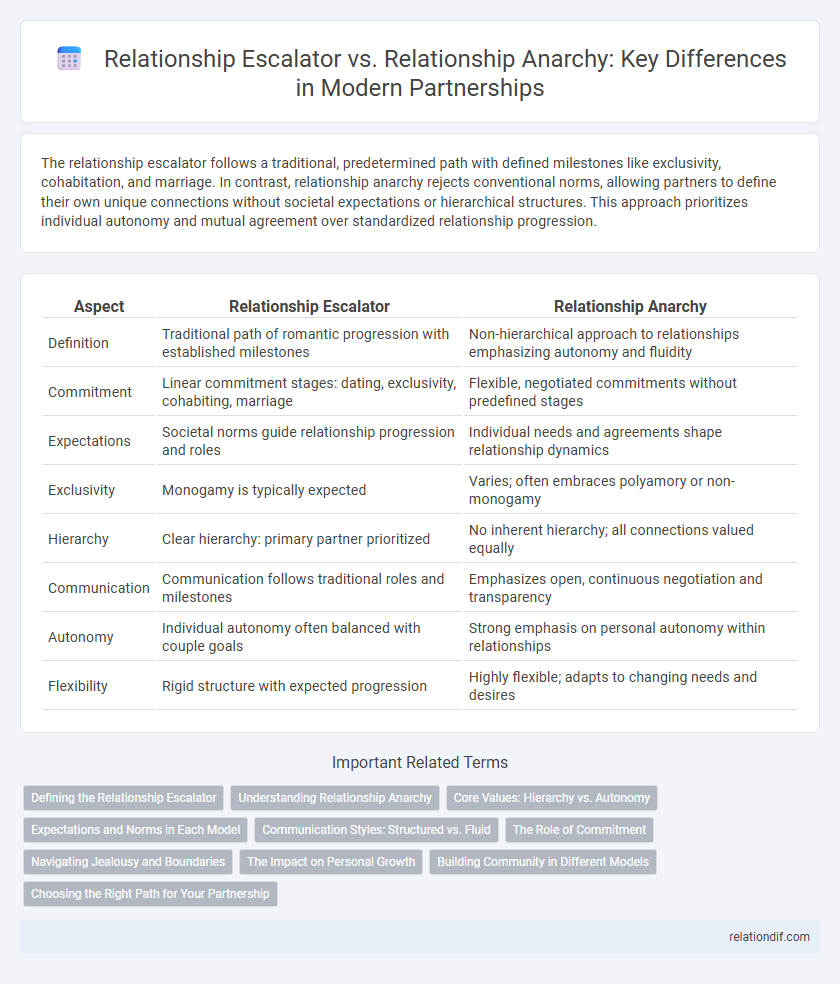The relationship escalator follows a traditional, predetermined path with defined milestones like exclusivity, cohabitation, and marriage. In contrast, relationship anarchy rejects conventional norms, allowing partners to define their own unique connections without societal expectations or hierarchical structures. This approach prioritizes individual autonomy and mutual agreement over standardized relationship progression.
Table of Comparison
| Aspect | Relationship Escalator | Relationship Anarchy |
|---|---|---|
| Definition | Traditional path of romantic progression with established milestones | Non-hierarchical approach to relationships emphasizing autonomy and fluidity |
| Commitment | Linear commitment stages: dating, exclusivity, cohabiting, marriage | Flexible, negotiated commitments without predefined stages |
| Expectations | Societal norms guide relationship progression and roles | Individual needs and agreements shape relationship dynamics |
| Exclusivity | Monogamy is typically expected | Varies; often embraces polyamory or non-monogamy |
| Hierarchy | Clear hierarchy: primary partner prioritized | No inherent hierarchy; all connections valued equally |
| Communication | Communication follows traditional roles and milestones | Emphasizes open, continuous negotiation and transparency |
| Autonomy | Individual autonomy often balanced with couple goals | Strong emphasis on personal autonomy within relationships |
| Flexibility | Rigid structure with expected progression | Highly flexible; adapts to changing needs and desires |
Defining the Relationship Escalator
The relationship escalator refers to a culturally ingrained progression of romantic milestones such as dating, exclusivity, cohabitation, engagement, and marriage, often viewed as the default path toward long-term commitment. It assumes a linear trajectory where each stage builds upon the previous one, emphasizing social validation and conventional norms. Contrasting with relationship anarchy, which rejects predetermined steps and embraces fluidity, the relationship escalator prioritizes structured growth and clear expectations in partnership development.
Understanding Relationship Anarchy
Understanding relationship anarchy involves rejecting traditional relationship hierarchies and embracing fluid, individualized connections based on mutual respect and consent. Unlike the relationship escalator model, which outlines a predefined progression from dating to commitment, relationship anarchy prioritizes autonomy, personal boundaries, and co-created relationship dynamics. This approach fosters authentic partnerships free from societal expectations, enhancing communication and emotional honesty between partners.
Core Values: Hierarchy vs. Autonomy
Relationship escalator emphasizes hierarchy by defining stages and milestones, prioritizing commitment and progression within a structured framework. Relationship anarchy values autonomy, rejecting traditional labels and paths to foster fluid, individualized connections. Core values in relationship escalator stress order and predictability, while relationship anarchy champions freedom and self-determination.
Expectations and Norms in Each Model
Relationship escalator follows predefined societal expectations and norms, guiding partners through stages like dating, commitment, cohabitation, and marriage. Relationship anarchy rejects these conventional milestones, emphasizing personalized agreements and fluid boundaries tailored to individual desires and values. Both models shape partner behavior and communication differently, with the escalator promoting predictability and the anarchy model fostering autonomy and flexibility.
Communication Styles: Structured vs. Fluid
Relationship escalator follows a structured communication style with clear expectations and defined stages, promoting predictability and mutual understanding. Relationship anarchy embraces a fluid communication approach, allowing partners to negotiate terms dynamically without predefined roles or milestones. This flexibility supports personalized interactions but requires ongoing, transparent dialogue to maintain clarity and consent.
The Role of Commitment
The role of commitment in the relationship escalator emphasizes a clear, linear progression of milestones such as exclusivity, cohabitation, and marriage, reflecting societal expectations of long-term stability. In contrast, relationship anarchy challenges these conventional commitments by embracing fluid, customizable bonds without predetermined stages, prioritizing individual autonomy and mutual agreements. Understanding these differing approaches highlights how commitment functions either as a structured pathway or a flexible, evolving dynamic in partnerships.
Navigating Jealousy and Boundaries
Navigating jealousy and boundaries in Partnership requires understanding the distinct dynamics of the relationship escalator and relationship anarchy. The relationship escalator emphasizes predefined milestones and exclusivity, which can trigger jealousy when expectations are unmet, requiring clear communication and boundary-setting to maintain trust. In contrast, relationship anarchy challenges traditional norms by prioritizing autonomy and fluid connections, demanding ongoing negotiation of personal boundaries and emotional transparency to manage jealousy healthily.
The Impact on Personal Growth
The relationship escalator often imposes predefined milestones that may limit individual exploration and personal growth by adhering to societal norms. Relationship anarchy, by rejecting these conventional expectations, encourages partners to define their connections uniquely, fostering greater self-awareness and emotional development. Personal growth thrives when individuals navigate relationships based on authentic desires rather than prescribed paths, enhancing autonomy and deeper interpersonal understanding.
Building Community in Different Models
Relationship escalator follows a traditional path of commitment stages, encouraging partnerships to progress through predefined milestones that foster stable community ties. In contrast, relationship anarchy rejects hierarchical relationship structures, promoting fluid connections and diverse support networks that broaden community inclusion. Both models contribute uniquely to building community by either strengthening long-term bonds or enhancing flexible, non-traditional social frameworks.
Choosing the Right Path for Your Partnership
Choosing the right path for your partnership involves understanding the dynamics of the relationship escalator versus relationship anarchy. The relationship escalator follows traditional milestones such as exclusivity, cohabitation, and marriage, providing a clear, socially recognized progression. Relationship anarchy rejects these predetermined stages, emphasizing autonomy, flexibility, and negotiated boundaries tailored to the unique needs of each partner.
relationship escalator vs relationship anarchy Infographic

 relationdif.com
relationdif.com